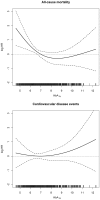Association of HbA1c values with mortality and cardiovascular events in diabetic dialysis patients. The INVOR study and review of the literature
- PMID: 21625600
- PMCID: PMC3097236
- DOI: 10.1371/journal.pone.0020093
Association of HbA1c values with mortality and cardiovascular events in diabetic dialysis patients. The INVOR study and review of the literature
Abstract
Background: Improved glycemic control reduces complications in patients with diabetes mellitus (DM). However, it is discussed controversially whether patients with diabetes mellitus and end-stage renal disease benefit from strict glycemic control.
Methods: We followed 78 patients with DM initiating dialysis treatment of the region of Vorarlberg in a prospective cohort study applying a time-dependent Cox regression analysis using all measured laboratory values for up to more than seven years. This resulted in 880 HbA(1c) measurements (with one measurement every 3.16 patient months on average) during the entire observation period. Non-linear P-splines were used to allow flexible modeling of the association with mortality and cardiovascular disease (CVD) events.
Results: We observed a decreased mortality risk with increasing HbA(1c) values (HR = 0.72 per 1% increase, p = 0.024). Adjustment for age and sex and additional adjustment for other CVD risk factors only slightly attenuated the association (HR = 0.71, p = 0.044). A non-linear P-spline showed that the association did not follow a fully linear pattern with a highly significant non-linear component (p = 0.001) with an increased risk of all-cause mortality for HbA(1c) values up to 6-7%. Causes of death were associated with HbA(1c) values. The risk for CVD events, however, increased with increasing HbA(1c) values (HR = 1.24 per 1% increase, p = 0.048) but vanished after extended adjustments.
Conclusions: This study considered the entire information collected on HbA(1c) over a period of more than seven years. Besides the methodological advantages our data indicate a significant inverse association between HbA(1c) levels and all-cause mortality. However, for CVD events no significant association could be found.
Conflict of interest statement
Figures


References
-
- Diabetes Control and Complications Trial Research Group. The effect of intensive treatment of diabetes on the development and progression of long-term complications in insulin-dependent diabetes mellitus. N Engl J Med. 1993;329:977–986. - PubMed
-
- Ansari A, Thomas S, Goldsmith D. Assessing glycemic control in patients with diabetes and end-stage renal failure. Am J Kidney Dis. 2003;41:523–531. - PubMed
-
- KDOQI. KDOQI Clinical Practice Guidelines and Clinical Practice Recommendations for Diabetes and Chronic Kidney Disease. Am J Kidney Dis. 2007;49:S12–154. - PubMed
-
- Ishimura E, Okuno S, Kono K, Fujino-Kato Y, Maeno Y, et al. Glycemic control and survival of diabetic hemodialysis patients–importance of lower hemoglobin A1C levels. Diabetes Res Clin Pract. 2009;83:320–326. - PubMed
Publication types
MeSH terms
Substances
LinkOut - more resources
Full Text Sources
Medical
Miscellaneous

